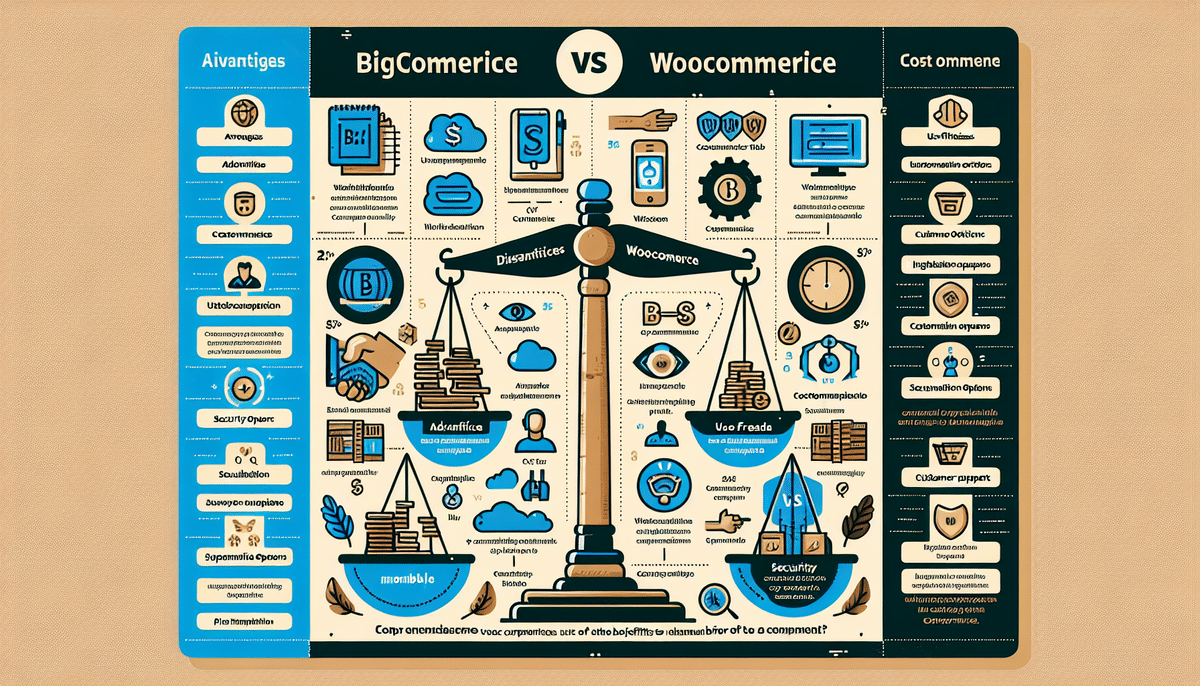Wix eCommerce vs WooCommerce: Comprehensive SEO Optimized Comparison
Choosing the right eCommerce platform is crucial for the success of your online store. With numerous options available, it's essential to make an informed decision based on your business requirements. This article provides an in-depth comparison of two popular eCommerce platforms—Wix eCommerce and WooCommerce (a WordPress plugin)—to help you determine which one best suits your business needs.
Introduction to eCommerce Platforms
eCommerce platforms are essential tools that enable businesses to create, manage, and scale their online stores. They offer a range of features including product management, shopping cart functionality, payment gateways, shipping management, and inventory control. According to Statista, the global eCommerce market is projected to reach $6.54 trillion by 2023, highlighting the importance of choosing the right platform to capture this growing market.
Key aspects of eCommerce platforms include:
- Product Management: Organizing and showcasing products effectively.
- Payment Gateways: Facilitating secure transactions.
- Shipping Management: Streamlining order fulfillment processes.
- Inventory Management: Tracking stock levels to prevent overselling.
- Integrations: Connecting with other tools like CRM and marketing software.
Choosing a platform that integrates seamlessly with your existing tools and provides robust analytics is vital for making data-driven decisions and enhancing operational efficiency.
Overview of Wix eCommerce
Wix eCommerce is a cloud-based platform that allows businesses to create professional online stores without any coding expertise. Renowned for its user-friendly interface, Wix offers a drag-and-drop website builder, a variety of customizable templates, and a suite of eCommerce features tailored to help you sell products online effectively.
Key advantages of Wix eCommerce include:
- User-Friendly Interface: Intuitive design tools suitable for beginners.
- Customizable Templates: A wide range of professionally designed templates.
- Flexibility: Options to add branding elements and integrate third-party apps.
- Built-In Marketing Tools: Features like email marketing and SEO optimization.
According to Wix’s 2023 User Report, over 200 million users have created websites using the platform, indicating its widespread adoption and reliability.
Overview of WooCommerce
WooCommerce is a highly popular open-source eCommerce plugin for WordPress websites. It transforms a standard WordPress site into a fully functional online store, offering extensive customization options to cater to diverse business needs. As of 2023, WooCommerce powers over 28% of all online stores, making it a formidable player in the eCommerce space.
Key benefits of WooCommerce include:
- Flexibility: Supports a wide range of products, including physical, digital, and services.
- Extensive Customizations: Thousands of themes and plugins available to enhance functionality.
- Scalability: Suitable for both small businesses and large enterprises.
- Community Support: A large community of developers and users for assistance and resources.
WooCommerce's integration with WordPress allows for unparalleled control over SEO, content management, and overall website performance.
Feature Comparison
Product Management
Both Wix and WooCommerce offer robust product management features, allowing you to add, edit, and categorize products with ease. However, WooCommerce provides more advanced options such as variable products, product bundles, and extensive inventory tracking.
Payment Gateways
Wix eCommerce supports multiple payment methods including credit/debit cards, PayPal, and offline payments. It integrates seamlessly with Stripe and Square for secure transactions.
WooCommerce offers over 140 payment gateways including PayPal, Stripe, Amazon Pay, and more, providing greater flexibility and options for international customers.
Shipping Management
Efficient shipping management is crucial for customer satisfaction. Wix eCommerce allows you to set up various shipping methods such as weight-based, flat-rate, and free shipping. You can also define shipping zones and rates for different regions.
WooCommerce integrates with major shipping carriers like USPS, FedEx, and UPS. This integration enables real-time shipping rates, label printing, and tracking, enhancing the overall shipping experience.
Inventory Management
Both platforms offer inventory management features to track stock levels and prevent overselling. WooCommerce provides more detailed inventory reports and supports automatic stock updates based on sales, making it ideal for businesses with large inventories.
Ease of Use
Wix eCommerce is renowned for its user-friendly interface, making it easy for beginners to set up an online store without any technical knowledge. The drag-and-drop builder allows for quick customization, and the platform provides guided tutorials and support resources.
On the other hand, WooCommerce requires a basic understanding of WordPress. While it offers greater flexibility and customization, it can be overwhelming for those without prior experience. However, extensive documentation, community forums, and numerous tutorials are available to assist users in navigating the platform.
Pricing Comparison
Understanding the cost structure of each platform is essential for budgeting and financial planning.
Wix eCommerce Pricing
Wix offers several pricing plans tailored to different business sizes:
- Business Basic: Starting at $23/month – suitable for small businesses.
- Business Unlimited: Starting at $27/month – includes additional features like subscriptions and multiple currencies.
- Business VIP: Starting at $49/month – offers priority support and other premium features.
Each plan includes hosting, SSL certification, and access to Wix's customer support.
WooCommerce Pricing
WooCommerce itself is a free plugin, but additional costs may include:
- Hosting: Ranges from $5 to $50/month depending on the provider and plan.
- Domain Name: Approximately $10-$15/year.
- Premium Themes and Plugins: Can add $50-$200 annually depending on requirements.
Overall, WooCommerce can be more cost-effective for businesses that prefer a pay-as-you-go model, especially those that require advanced features through premium plugins.
Design and Customization Options
Wix eCommerce offers a selection of over 500 customizable templates designed to be aesthetically pleasing and responsive across devices. The drag-and-drop editor allows for easy customization without the need for coding. However, customization is somewhat limited to the options provided within Wix’s ecosystem.
WooCommerce excels in customization flexibility. Being an open-source platform, it allows full access to HTML, CSS, and PHP, enabling businesses to create highly personalized and unique store designs. Additionally, with thousands of themes and plugins available, WooCommerce can be tailored to meet virtually any design requirement.
Payment and Shipping Options
Payment Options
Wix eCommerce supports multiple payment methods including credit/debit cards, PayPal, and offline payments. Integration with Stripe and Square ensures secure and reliable transactions.
WooCommerce offers a vast array of payment gateways, accommodating over 140 options including PayPal, Stripe, Amazon Pay, and regional payment solutions. This extensive range allows businesses to cater to a global customer base effectively.
Shipping Options
Efficient shipping is key to customer satisfaction. Wix eCommerce provides flexible shipping options such as weight-based, flat-rate, and free shipping. Businesses can define shipping zones and rates tailored to different regions.
WooCommerce integrates with major shipping carriers like USPS, FedEx, and UPS. This integration facilitates real-time shipping rates, label generation, and tracking, streamlining the fulfillment process.
Integrations and Add-ons
Wix eCommerce offers integrations with popular tools such as Google Analytics, Facebook Pixel, and Mailchimp. Additionally, businesses can enhance their store's functionality by adding custom code snippets through the HTML widget.
WooCommerce boasts a vast ecosystem of over 55,000 plugins, allowing for extensive functionality extensions including email marketing, SEO, social media integrations, and advanced analytics. This makes WooCommerce highly adaptable to various business needs and scalable as your business grows.
Customer Support
Wix eCommerce provides comprehensive customer support, including 24/7 assistance via phone, email, and live chat. Their extensive knowledge base and community forums offer additional resources for troubleshooting and learning.
WooCommerce does not offer direct customer support but benefits from a large and active community of users and developers. Extensive documentation, forums, and third-party support services are available to assist with any issues or customizations.
Pros and Cons
Wix eCommerce
Pros:
- Intuitive and easy-to-use platform.
- No technical knowledge required.
- Quick and seamless setup process.
- Variety of customizable templates.
- Built-in marketing and SEO tools.
Cons:
- Limited customization beyond provided templates.
- Monthly subscription fees can add up.
- Less scalable for large businesses compared to WooCommerce.
- Dependence on Wix’s ecosystem for integrations.
WooCommerce
Pros:
- Highly customizable and flexible platform.
- Access to thousands of themes and plugins.
- Free to use with optional paid extensions.
- Scalable to support businesses of all sizes.
- Strong community support and resources.
Cons:
- Requires technical knowledge of WordPress.
- Additional costs for hosting, premium themes, and plugins.
- Can be overwhelming for beginners due to extensive customization options.
- Responsibility for managing security and updates.
Final Verdict: Choosing the Right Platform for Your Business
The decision between Wix eCommerce and WooCommerce hinges on your specific business needs and technical expertise. If you prioritize ease of use, quick setup, and minimal technical maintenance, Wix eCommerce is an excellent choice. It is ideal for small to medium-sized businesses looking for a straightforward solution with built-in marketing tools.
Conversely, if your business demands extensive customization, scalability, and you have the technical resources to manage a more complex setup, WooCommerce is the superior option. It offers unparalleled flexibility and the ability to tailor your online store to meet unique requirements, making it suitable for businesses of all sizes aiming for long-term growth.
Consider factors such as your budget, the level of customization you require, and your ability to manage technical aspects when making your decision. Both platforms offer robust features to help you build a successful online store, so choose the one that aligns best with your business goals and capabilities.
Conclusion: Making an Informed Choice
Selecting the right eCommerce platform is a pivotal step in establishing and growing your online business. By thoroughly evaluating platforms like Wix eCommerce and WooCommerce based on features, ease of use, pricing, customization options, and support, you can make a strategic decision that best fits your business model. Whether you opt for the simplicity of Wix or the flexibility of WooCommerce, both platforms provide the tools and functionalities necessary to create a thriving online store.




















